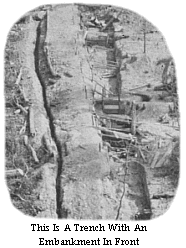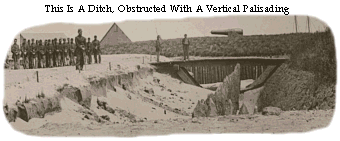Military engineering as it was practiced during the middle period
of the nineteenth century made a definite distinction between a ditch and
a trench. To anyone not steeped in the jargon of the period the difference
may seem remote; both were (and are, for that matter) extended excavations
that might run from a few feet to an indefinite length across the landscape.
But taken in the context of the period and subject the distinction between
a ditch and a trench imparts quite a bit of information about particular
types of field fortifications
and
 the expectations surrounding their design and construction.
To the point: a ditch was defined as a linear excavation on the engaged or
exterior side of a parapet or earth embankment intended to serve as both
cover and obstacle. A trench, on the other hand, was defined as a linear
excavation on the unengaged or interior side of a protective embankment. the expectations surrounding their design and construction.
To the point: a ditch was defined as a linear excavation on the engaged or
exterior side of a parapet or earth embankment intended to serve as both
cover and obstacle. A trench, on the other hand, was defined as a linear
excavation on the unengaged or interior side of a protective embankment.
 In both cases the excavation was intended as the
source of material required to raise the protective embankment. Both trench
and ditch were proportioned to produce a sufficient volume of material to
give the embankment a height and thickness necessary to intercept hostile
fire. There the similarity ends. A field work with a trench and embankment
profile (such as rifle pits, siege parallels, and rifle trenches) assumed
that the depth of the ditch would be combined with the height and thickness
of the embankment to provide cover from hostile fire; there was no general
assumption that this sort of field work would also serve as a physical barrier
to the approach of an attacking body of troops. Troops deployed in a trench
were assumed to stand either at the bottom of the trench or on a step cut
into the forward side of the trench to deliver their fire. In short, the
primary defensive activity carried out in a field work with a trench and
embankment profile occurred in the trench itself. Trench based field works
were also seen as having the advantage of allowing troops occupying them
to undertake offensive movements; it was generally thought (and experience
generally agreed) that a field work with a trench and embankment profile
presented as little obstacle to the troops defending them as they did to
enemy troops attacking them. In both cases the excavation was intended as the
source of material required to raise the protective embankment. Both trench
and ditch were proportioned to produce a sufficient volume of material to
give the embankment a height and thickness necessary to intercept hostile
fire. There the similarity ends. A field work with a trench and embankment
profile (such as rifle pits, siege parallels, and rifle trenches) assumed
that the depth of the ditch would be combined with the height and thickness
of the embankment to provide cover from hostile fire; there was no general
assumption that this sort of field work would also serve as a physical barrier
to the approach of an attacking body of troops. Troops deployed in a trench
were assumed to stand either at the bottom of the trench or on a step cut
into the forward side of the trench to deliver their fire. In short, the
primary defensive activity carried out in a field work with a trench and
embankment profile occurred in the trench itself. Trench based field works
were also seen as having the advantage of allowing troops occupying them
to undertake offensive movements; it was generally thought (and experience
generally agreed) that a field work with a trench and embankment profile
presented as little obstacle to the troops defending them as they did to
enemy troops attacking them.
 A ditch on the exterior side of a field work was
another matter. In this case the ditch was assumed to be deep enough (6 to
8 feet) and wide enough (12 or more feet) to present a significant obstacle
to enemy troops attempting to break into an attacked field work. Here the
ditch functioned as an obstacle and did not serve as an integral element
of the protective cover that shielded troops occupying the work from hostile
fire. Cover was provided exclusively by the parapet. If troops defending
a work might at times perch themselves on top of the parapet to get a better
angle of fire on attacking troops or to meet them if they happened to get
in the ditch and scale the scarp in force, there was no assumption that the
defenders would be able, under any circumstances, to cross the ditch to conduct
any offensive movement whatsoever. This sort of thing would be done by reserves
positioned outside and behind the field work, not by troops in the work itself.
Although some defenses (galleries and caponnieres) might be placed in the
ditch, the primary defensive activity that would repel an attack did not
occur in the ditch, but on the parapet behind it. A ditch on the exterior side of a field work was
another matter. In this case the ditch was assumed to be deep enough (6 to
8 feet) and wide enough (12 or more feet) to present a significant obstacle
to enemy troops attempting to break into an attacked field work. Here the
ditch functioned as an obstacle and did not serve as an integral element
of the protective cover that shielded troops occupying the work from hostile
fire. Cover was provided exclusively by the parapet. If troops defending
a work might at times perch themselves on top of the parapet to get a better
angle of fire on attacking troops or to meet them if they happened to get
in the ditch and scale the scarp in force, there was no assumption that the
defenders would be able, under any circumstances, to cross the ditch to conduct
any offensive movement whatsoever. This sort of thing would be done by reserves
positioned outside and behind the field work, not by troops in the work itself.
Although some defenses (galleries and caponnieres) might be placed in the
ditch, the primary defensive activity that would repel an attack did not
occur in the ditch, but on the parapet behind it.
It should perhaps be noted in passing that the ditch of a field
work constructed during the nineteenth century can not by any stretch of
accurate description be referred to as a moat. This happens with ugly frequency.
 "Moat," as far as the art and science of fortification went,
was an archaic term even during the nineteenth century and is quite a little
anachronism now and would have been so in former times under current reference.
Moats work for medieval castles and have their places, this just isn't one
of them. There is, it should also be added, something of a structural and
functional difference between a medieval castle's moat and the ditch of permanent
and field fortifications constructed from the seventeenth to the middle of
nineteenth centuries. An explanation of which is a bit beyond the scope of
this definition. "Moat," as far as the art and science of fortification went,
was an archaic term even during the nineteenth century and is quite a little
anachronism now and would have been so in former times under current reference.
Moats work for medieval castles and have their places, this just isn't one
of them. There is, it should also be added, something of a structural and
functional difference between a medieval castle's moat and the ditch of permanent
and field fortifications constructed from the seventeenth to the middle of
nineteenth centuries. An explanation of which is a bit beyond the scope of
this definition. |